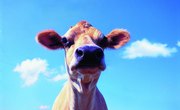Though all cattle are in the family Bovidae and of the species Bos taurus, there are distinct differences between dairy and beef cattle. Dairy cattle are bred and raised for their ability to produce milk and beef cattle are raised for meat. The cows are built differently and utilize feed differently, according to their purpose and breed.
Physical Differences
When you pass by a field of cattle, you may not be able to discern between a dairy cow and a beef cow, but when you put them side-by-side, the differences are clear to see. The striking feature about a dairy cow is that she looks thin. The dairy cow lives to produce milk, and much of her body's energy is dedicated to just that cause. She naturally tends toward a more delicate appearance based on her genetic makeup. Other physical attributes of the dairy cow include:
- Long, thin neck
- Obvious spine
- Fine-boned legs
- Angular body
A beef cow is all about meat and her energy is channeled into building muscle eventually to be used for steaks, burgers and roasts. This is a robust, sturdy cow, characterized by:
- A short, stout neck
- Thick back without any visible backbone
- Round leg bones and body
Tips
Male cattle are referred to as bulls if left intact, or steers, if castrated. Female cattle are referred to as heifers when they're young and haven't given birth and cows when they're mature. Cows, steers or bulls all can be beef cattle and only females produce milk.
Input and Output
A typical dairy cow produces about 8 gallons of milk and eats approximately 50 pounds of feed each day. A beef cow requires approximately 6 pounds of feed for every pound of meat produced. However, a grazing beef cow will eat grass as she grows to more than half her ultimate weight, which takes the feed requirement down to approximately 2.5 pounds of feed for every pound of meat. A grazing cow requires between 7 and 25 pounds of forage per pound of meat. Some breeds of cattle use feed more efficiently than others; for example, the Holstein usually eats 10 to 15 percent more feed than other beef breeds.
After slaughtering a beef cow, there's about 61 percent of the cow's original weight left, referred to as hanging weight or the weight on the rail. However, as time passes and the meat is processed for market, an additional 18 percent is due to moisture loss as well as removing bones and fat, for a total of 57 percent loss of original weight. A 1,000 pound cow in the field ends up producing approximately 430 pounds of meat. As with feed, breed can make a difference regarding how much beef is yielded from a cow; Holsteins have about 5 percent less yield than other beef cattle.
Different Purposes, Different Breeds
Not just any cow is suited for milking and some cattle are better suited as beef cattle. Breeds are chosen for their output and how they adjust to their home climate. Popular breeds of beef cattle include:
- Angus, an adaptable type developed in Scotland but used extensively in the United States and United Kingdom
- Hereford, very popular, spreading from England to the United Kingdom, New Zealand, Australia and the Americas
- Simmental, widespread after starting in Switzerland
- Limousin, originated in France and now popular in North America
- Shorthorn, from England but now widely used in cattle-producing countries
Breeds of dairy cattle include:
- Guernsey, a productive cow from the Isle of Guernsey now popular in the United Kingdom, Australia and North America
- Jersey, a feed-efficient cow from the United Kingdom used throughout the world
- Holstein Friesian, a large milk producer from the Netherlands who's now used in South Africa, Australia and North and South America
- Ayrshire, a hardy breed used throughout temperate climates after starting in Scotland
Doing Double Duty
Some cattle can be used for meat or milk, known as dual-purpose cattle. The beefmaster, Normande, shorthorn, Scottish highland and red poll are two dual purpose breeds of cattle.



